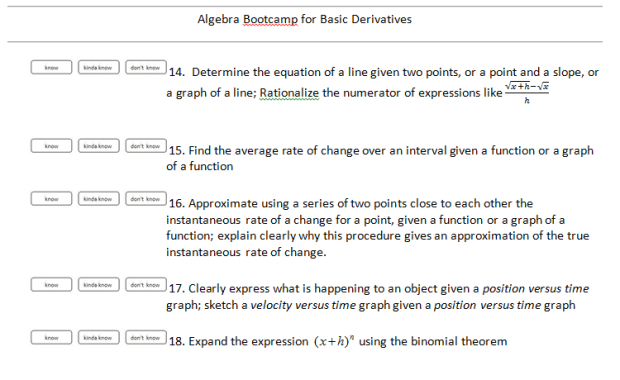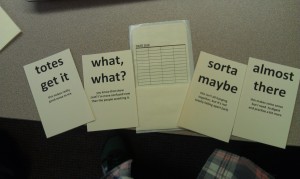I’ve posted about my adventures in Standards Based Grading… more so when I first started doing it, less so this year.
I overall have been happy with it, but three weeks ago I had a moment of frustration when I almost decided to abandon SBG completely in the fourth quarter (which will be upon us soon). The impetus: in my two SBG classes (non-AP Calculus), over half the students did not do the nightly work.
For some context, I require nightly work, but it is not graded. (This is not everyone’s philosophy, but I believe in nightly work.) I used to go around and check to see that it was done, but it never factored into their grades. For the most part, kids did it, so I stopped walking around. Things were going well.
For some more context: All the students in the class are seniors. I teach at a really awesome independent school in Brooklyn, and in general, kids are motivated. The kids in my class mostly don’t hate math (there are some exceptions), but they mostly don’t loooove math either (there, again, are some exceptions). It’s a really good group, and I felt things were going solidly for the first two quarters.
Then came the fateful day when I came to class and I saw the apathy and excuses for not doing the nightly work. It was horrible. In one class, I kinda lost it, and in the other, I tried to reign myself a bit. I mean, I didn’t start throwing chairs and stuff, but I definitely raised my voice, expressed my serious dissatisfaction, and (I admit it) I threatened to start grading nightly work. It wasn’t a moment I was proud of, because usually I’m less impulsive and don’t let things get to me. But I was M-A-D.
I talked it over with the other calculus teacher, who shared that he had been noticing a serious apathy and lack of work ethic.
One student emailed me apologizing for his lack of work, and I don’t know why, but that really meant a lot for me. It helped me table my frustration.
I needed spring break to cool down and see if I really needed to revisit SBG or not. That one incident really floored me. There are a few things I needed to think about:
1) There is a good possibility that this happens every year around this time. It’s 3rd quarter, a couple weeks before spring break. I have such a terrible memory and block out all the bad things… so this may be an annual occurrence. The inauguration of senioritis.
2) Although I talked about SBG a lot at the beginning of the year, I did not revisit it/talk about it as regularly as I have in the past. So I don’t know how much my kids have really understood about what we’re doing. I mean, they understood at the beginning. But I think it has morphed into something else in their minds.
The thing is, though, I started to worry that SBG wasn’t serving the purposes I adopted it for:
1) Independence and Responsibility
2) Students learning about their learning process
3) Clarity about what students know and what they don’t know
4) Making mistakes, but learning from them
I was having, and still sort of am, having a true crisis of faith. Because if SBG didn’t address these things, what’s the point? And clearly much of this is on me. Because careful implementation is crucial and that is my responsibility. I’ve seen it be wildly successful with students since starting, students who wouldn’t have a chance in hell in a traditional class to learn and be awesome at calculus. And for those kids, the kids SBG really works for, it’s enough to keep me invested and wanting to continue.
But the force I’ve been working against since I started doing it is:
I’m SBG in a sea of non-SBG.
In a school where kids are focused on traditional grades. And so when push comes to shove, even kids who understand and are on board with my nuanced understanding on SBG have to make decisions: it’s 1am and I am exhausted and have Spanish homework and calculus to do.
Calculus goes.
It just does. And yeah, once in a blue moon, I’m okay with that. It’s life. They’re learning to make choices. But it doesn’t happen once in a blue moon, because I’m fighting a system I have no chance of winning in. Because what I’ve found is that kids who make this choice don’t learn from this choice. And so some kids (not all, mind you) aren’t really putting in the effort.
So kids come to class without having done the work. Class goes slower because we aren’t all on the same page. Students take assessments and don’t do awesomely the first time. That’s okay, occasionally, because that’s the point… But ideally, reassessments should be more like a safety net, not crutches. That’s what we’re supposed to get them to learn, that’s what we want them to see. They can do it, if they figure out their learning process. And so by the third quarter (where I’m at), this should be where we’re at.
And here’s the thing: for the kids who have it as a crutch, I am not that successful at getting them to change their habits so reassessments become less frequent, and more like a safety net. They aren’t learning about their learning, and making changes. It’s just ignore, reassess, ignore, reassess, reassess, ignore… And I know some of that is on me. But I can’t get over how hard it is for me to do SBG effectively when calculus will always come last, when push comes to shove. And I hate that.
I’m not really asking for commiseration. I just wanted to post my thoughts here, because that’s why I have a blog. Duh.
If you do want to chime in, I’d love to hear:
1) What concrete things do you do to keep the philosophy, spirit, understanding of SBG alive… so that it doesn’t become a mechanized system by the third quarter?
2) If you are in a school that isn’t SBG, have you found any ways to combat the notion “SBG class can come last”?
3) If you are teaching SBG in any school, what mechanisms/procedures do you have to help kids individually understand how they learn, and how SBG can help them learn how to learn better? Do any of you have individual conferences with your kids or anything? Do you have them reflect about what they’re learning (or not) through SBG regularly, and do you respond to those reflections?
I realize that I have the systems of SBG smoothly set up, but I need to work on the other stuff… keep my eye on the reasons I’m doing it and making sure they come into sharp relief, instead of fading into the background as they tend to do as the keeping-afloat-teaching-day-to-day takes hold.
PS. I don’t want this to imply that kids don’t do their work with SBG, if you’re reading this out and thinking of starting it. It’s not like it’s a epidemic. But there are enough of them who are inconsistent enough with their work that it has become problematic. And then that day, that horrible day, has gotten me to think about some big issues. To be clear, I ended last year by making the statement: “My conclusion: although not perfect, this was a wildly successful year for Standards Based Grading in calculus” (read here for every student response to the survey I gave).
















